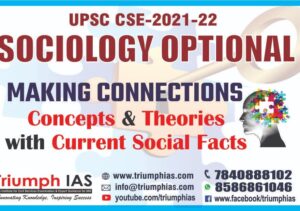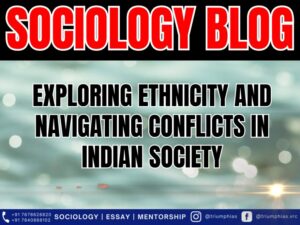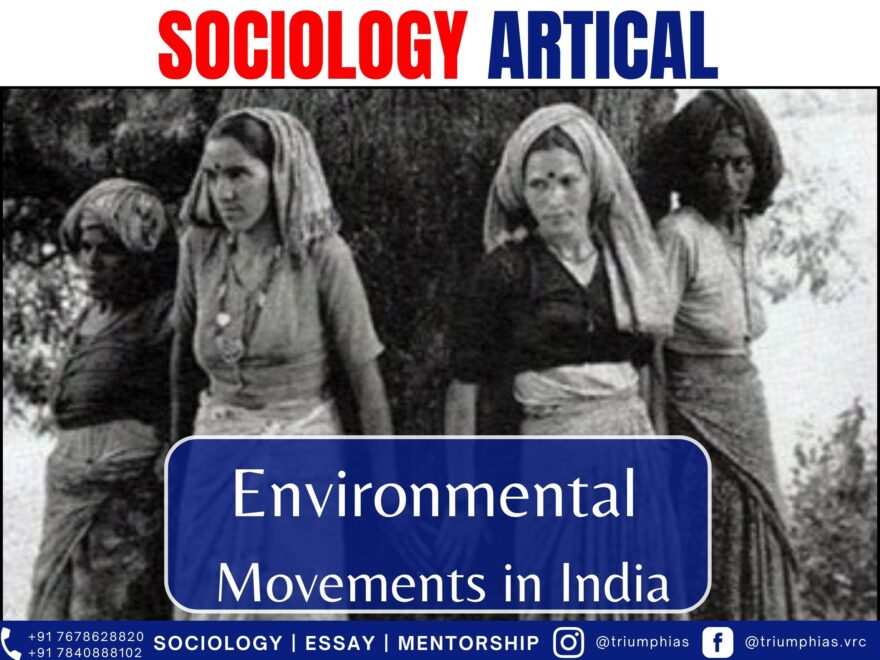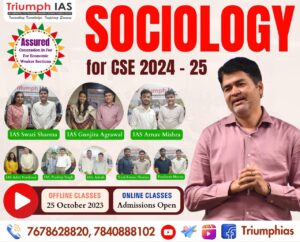Environmental Movements in India.
Relevant for Sociology Optional for Civil Service Examination.
Paper 2: Unit-13 Social Movements in modern India

Environmental Movements in India.
For a long time, the main focus has been on development. People have been worried for many years about the excessive use of our natural resources due to a development model that continuously creates new needs, leading to even more use of our already limited natural resources. This approach to development has been criticized because it assumes that everyone will benefit from it. However, big projects like dams force people to leave their homes and jobs. Industries do the same to farmers, taking away their lands and means of making a living. Industrial pollution also causes additional problems. In this discussion, we’ll use examples from environmental movements to explore various related issues.
The Chipko movement in the Himalayan foothills is a key ecological movement where local communities, including many women, actively worked to save their nearby oak and rhododendron forests from being cut down by government contractors. As explained by Ramachandra Guha in “Unquiet Woods”, the villagers depended on these forests for essential needs like firewood and fodder. The villagers, by hugging trees, opposed the government’s plan, prioritizing their basic survival needs over the government’s aim to profit from selling timber.
The Chipko movement didn’t only highlight social differences (between the common villagers and the profit-focused government) but also emphasized the importance of ecological sustainability. The deforestation led to severe environmental issues like floods and landslides in the area. The villagers saw their survival and the forest’s well-being as interconnected – they relied on the forest for their needs and also valued its inherent ecological importance.
Moreover, the Chipko movement displayed the villagers’ dissatisfaction towards a distant government that seemed to ignore their needs and concerns. The movement embodied economic, ecological, and political grievances.
Gadgil and Guha, in “This Fissured Land”, noted that environmental awareness isn’t new in India. They discussed that the disconnect between nature and culture in India began during colonial times with intense forest exploitation and industrialization, affecting indigenous communities who held strong cultural ties to the forests. These communities were among the early, unrecognized champions of India’s environmental movements.
Madhav Gadgil mentions that environmental movements address various issues such as rights related to forests and lands, dams, commercial mining exploitation, and control over marine resources, among others. There are also several other environmental problems like air and water pollution, waste management, resource scarcity, soil erosion, desertification, deforestation, genetically modified foods, loss of biodiversity, river pollution, and conflicts between humans and animals. There are also concerns related to environmental disasters like the floods in Uttarakhand in 2013, and industrial disasters such as the Bhopal tragedy and the Chernobyl accident. Some environmental issues, like reducing air pollution or protecting biodiversity, are common concerns that benefit everyone, not just specific groups of people.
Environmental movements became more prominent in the 1970s alongside the rise of New Social Movements. During this period, there was a realization that increasing development activities were harming the environment. In the same era, the concept of sustainable development was recognized and promoted globally, beginning with a UN conference in Stockholm.

Environmental movements are categorized as follows:
Pure environmental movements focused solely on conservation, such as the air pollution movement in Delhi and the movement against water pollution due to the leather industry in Chennai. These movements are primarily in urban areas, led mainly by NGOs and driven by the elite or middle class.
Combined movements like the Tehri movement by Sundar Bahugune, Chipko Movement by Chandi Prasad Bhat, and Narmada Bachao Andolan by Medha Patker, which address broader issues like livelihood and the rights of the poor. Other successful movements include the water conservation efforts by ‘waterman’ Rajender Singh of Gujarat and the Save Chilka Campaign.
Environmental movements are also grouped based on their strategies such as Gandhian, Marxian, and reconstructive approaches, which propose alternatives. Gadgil and Guha outline four major types of environmental movements in India based on vision, ideology, and strategy.
In response to global challenges like global warming and biodiversity loss, environmental movements have globally mobilized to raise awareness and influence governments. These movements aim to find a balance between development and environmental protection. In India, the government and courts have taken steps to address environmental issues, like introducing CNG vehicles in Delhi and establishing ‘Green Benches’ in the Supreme Court. Various policies and acts, like the ‘National Environmental Policy, 2005’ and ‘Scheduled Tribes and Other Traditional Forest Dweller’s (Recognition of Forest Rights) Act 2006’, have been implemented to address these concerns.
In conclusion, social movements in India primarily focus on two things:
Maintaining system stability by slowing rapid social changes and upholding existing values and norms.
Attempting system change by replacing old structures with new ones to induce improvement.
Reference: Static Portion
Related Blogs…
 |
 |
Frequently Asked Questions:
1. Question: Define the term “ethnic movement” and provide an example from India.
Answer: An ethnic movement refers to a collective effort by a group sharing common cultural, linguistic, or religious traits, seeking to assert their identity and rights; an example from India is the Khalistan Movement in Punjab.
2. Question: Identify the main objectives behind the Gorkhaland ethnic movement.
Answer: The Gorkhaland ethnic movement primarily seeks to establish a separate state for India’s Nepali-speaking population in the Darjeeling region, advocating for linguistic and cultural recognition and political autonomy.
3. Question: What was the Operation Blue Star, and which ethnic movement was it related to?
Answer: Operation Blue Star was a military action in 1984, aiming to remove Sikh militants hiding in the Golden Temple in Amritsar; it is related to the Khalistan movement, which sought a separate Sikh country.
4. Question: Mention a critical factor that triggered the emergence of ethnic movements in India, as discussed by Dipankar Gupta.
Answer: Dipankar Gupta emphasized that ethnicity is fundamentally a political process, wherein caste and religion, the key components of identity formation, are politicized by leaders for vested interests.
5. Question: What were the primary reasons for the Assam Ethnicity conflicts involving Bodo tribals and Bengali Muslim settlers?
Answer: The Assam Ethnicity conflicts primarily stemmed from issues related to immigration, land rights, and resource allocation, leading to clashes, riots, and evolving relationships among indigenous communities to address challenges.
6. Question: Briefly describe the role of the Dravidian Movement in terms of caste and societal structure.
Answer: The Dravidian Movement, led notably by E.V. Ramasamy, aimed to establish an egalitarian society, focusing on anti-Brahmanism and advocating for equal rights for backward castes, while also introducing reforms like self-respect marriages.
7. Question: Name the prominent ethnic movements in North-East India and specify one common objective.
Answer: Prominent ethnic movements in North-East India include the Nagas’ and Mizos’ struggles; a common objective was to gain autonomy and recognition for their distinct tribal identities and cultural uniqueness.
8. Question: What is the key argument of Gail Omveldt regarding traditional Indian society and multiculturalism?
Answer: Gail Omveldt opposed romanticizing traditional Indian society, arguing that hierarchy has always dominated it and dismissing the notion that multiculturalism is an intrinsic feature of Indian society as a myth.
9. Question: Briefly explain the social hierarchy factor as a contributing element to ethnic movements as suggested by Olzak.
Answer: Olzak suggests that the construction of hierarchies among ethnic communities, which often leads to the suppression of one group by another, is a key factor that can instigate social and ethnic movements.
10. Question: Identify one consequence of the unequal economic development factor within the context of ethnic movements in India.
Answer: One consequence of unequal economic development is the marginalization and underdevelopment of certain groups, leading to feelings of alienation and sometimes initiating ethnic movements as these groups strive for equality and recognition.
GS Related Practices Questions…
To master these intricacies and fare well in the Sociology Optional Syllabus, aspiring sociologists might benefit from guidance by the Best Sociology Optional Teacher and participation in the Best Sociology Optional Coaching. These avenues provide comprehensive assistance, ensuring a solid understanding of sociology’s diverse methodologies and techniques.
META TAGS:
Ethnic Movements, ethnic movements in india, ethnic movement in sociology, Punjab Movement, North-East Ethnic Movements, Gorkhaland Movement, Dravidian Movement, Assam Ethnicity, Ethnic Conflicts, Sociopolitical Impact, India, Ethnic Consciousness, Ethnic Rights, Political Crisis, Economic Development, Cultural Disparities, Khalistan Movement, Nagaland, Mizoram, Multiculturalism, Political Economy, Identity Formation, Social Hierarchies, Bodo Tribals, Bengali Muslim Settlers, Anti-Sikh Riots, Operation Blue Star, Unequal Development, Ethnic Violence, Political Mobilization

Why Vikash Ranjan’s Classes for Sociology?
Proper guidance and assistance are required to learn the skill of interlinking current happenings with the conventional topics. VIKASH RANJAN SIR at TRIUMPH IAS guides students according to the Recent Trends of UPSC, making him the Best Sociology Teacher for Sociology Optional UPSC.
At Triumph IAS, the Best Sociology Optional Coaching platform, we not only provide the best study material and applied classes for Sociology for IAS but also conduct regular assignments and class tests to assess candidates’ writing skills and understanding of the subject.
Choose The Best Sociology Optional Teacher for IAS Preparation?
At the beginning of the journey for Civil Services Examination preparation, many students face a pivotal decision – selecting their optional subject. Questions such as “which optional subject is the best?” and “which optional subject is the most scoring?” frequently come to mind. Choosing the right optional subject, like choosing the best sociology optional teacher, is a subjective yet vital step that requires a thoughtful decision based on facts. A misstep in this crucial decision can indeed prove disastrous.
Ever since the exam pattern was revamped in 2013, the UPSC has eliminated the need for a second optional subject. Now, candidates have to choose only one optional subject for the UPSC Mains, which has two papers of 250 marks each. One of the compelling choices for many has been the sociology optional. However, it’s strongly advised to decide on your optional subject for mains well ahead of time to get sufficient time to complete the syllabus. After all, most students score similarly in General Studies Papers; it’s the score in the optional subject & essay that contributes significantly to the final selection.
“A sound strategy does not rely solely on the popular
Opinion of toppers or famous YouTubers cum teachers.”
It requires understanding one’s ability, interest, and the relevance of the subject, not just for the exam but also for life in general. Hence, when selecting the best sociology teacher, one must consider the usefulness of sociology optional coaching in General Studies, Essay, and Personality Test.
The choice of the optional subject should be based on objective criteria, such as the nature, scope, and size of the syllabus, uniformity and stability in the question pattern, relevance of the syllabic content in daily life in society, and the availability of study material and guidance. For example, choosing the best sociology optional coaching can ensure access to top-quality study materials and experienced teachers. Always remember, the approach of the UPSC optional subject differs from your academic studies of subjects. Therefore, before settling for sociology optional, you need to analyze the syllabus, previous years’ pattern, subject requirements (be it ideal, visionary, numerical, conceptual theoretical), and your comfort level with the subject.
This decision marks a critical point in your UPSC – CSE journey, potentially determining your success in a career in IAS/Civil Services. Therefore, it’s crucial to choose wisely, whether it’s the optional subject or the best sociology optional teacher. Always base your decision on accurate facts, and never let your emotional biases guide your choices. After all, the search for the best sociology optional coaching is about finding the perfect fit for your unique academic needs and aspirations.
To master these intricacies and fare well in the Sociology Optional Syllabus, aspiring sociologists might benefit from guidance by the Best Sociology Optional Teacher and participation in the Best Sociology Optional Coaching. These avenues provide comprehensive assistance, ensuring a solid understanding of sociology’s diverse methodologies and techniques. Sociology, Social theory, Best Sociology Optional Teacher, Best Sociology Optional Coaching, Sociology Optional Syllabus.
Best Sociology Optional Teacher, Sociology Syllabus, Sociology Optional, Sociology Optional Coaching, Best Sociology Optional Coaching, Best Sociology Teacher, Sociology Course, Sociology Teacher, Sociology Foundation, Sociology Foundation Course, Sociology Optional UPSC, Sociology for IAS,
Follow us :



Find More Blogs…
| Compare and contrast Karl Marx’s and Max weber’s | Karl Marx- Historical Materialism |
| Talcott Parsons : Social system | Scope of the subject and comparison with other social sciences |


